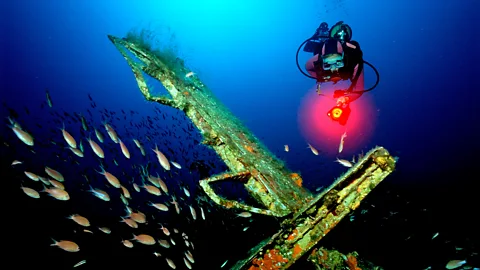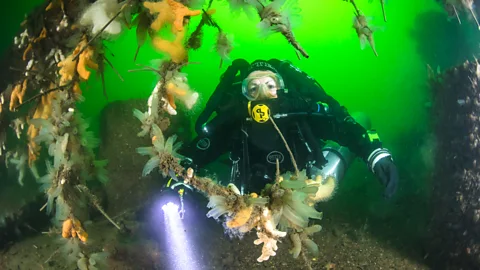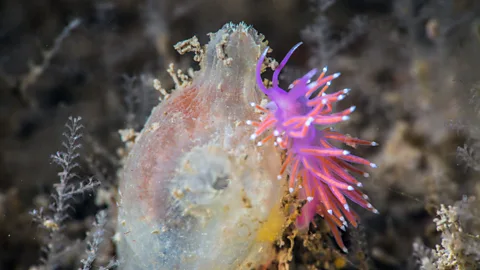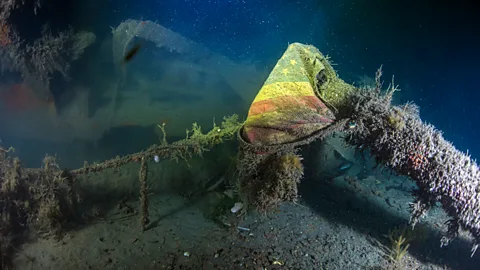D-Day shipwrecks were a WW2 time capsule – now they are home to rich ocean-floor life
 Getty images
Getty imagesAmong the 80-year-old sunken D-Day wrecks that line the coasts of Britain and , wildlife is thriving on the wreckage of war.
Stretching for miles along England's Devonshire coast, between the sea and a patchwork of hills, lies the shingly expanse of Slapton Sands. Humpback whales can occasionally be spotted offshore. A thatched pub at the far end sells fish and chips in an oak-beamed bar. And each year, at dawn on 27 April, hundreds of dead soldiers rise up out of the waves and march across the fields. Or so goes a local ghost-story.
The tale has its roots in tragedy. In the spring of 1944, the coastline had become a training area for American troops. Their mission was to complete a secret, full-scale practice of the D-Day invasion of Utah Beach in Nazi-occupied – part of an operation in which 160,000 Allied troops landed along 50-miles (80km) Normandy coast. But disaster struck when German E-boats snuck among the flotilla, torpedoing the gasoline-loaded ships, and leaving scenes of burning carnage in their wake.
More than 700 Americans died in the ensuing chaos: one of the largest single-incident losses for the US after the bombing of Pearl Harbour. The figure is much higher than the death toll for the eventual assault on Utah. Across all the landings on D-Day, an estimated 4,400 allied troops and thousands more Germans were lost.
Today, visual reminders of both the D-Day landings and its preparatory exercises are few and far between. Yet beneath the waves, tanks still litter the seafloor – alongside ships, landing craft, planes and an artificial harbour. And it is among these 80-year-old wrecks that an even more intriguing tale of life-after-death can be found.
 Marcus Blatchford
Marcus BlatchfordSteve Mortimer is a diver who specialises in identifying wrecks around UK waters. "Wrecks are a time-capsule underwater. They're very moving: the final resting place of people who fought for our country," he says.
On wrecks from World War Two, you may at first spot the paraphernalia, Mortimer notes: guns, degraded ships and even – on the Leopoldville, which sank off Cherbourg in 1944 – the helmets of GI soldiers. But then, he adds, you start to notice that these man-made relics are not alone.
"Gigantic" mushroom-like sea anemones, as big as your fist, cover ships in their hundreds and trap plankton in their feathery tendrils. Starfish cling to hulls. Fish, which would normally use natural reefs for cover, take up residence: pollock, ling, conger eels and sea bass, among others.
"It is fascinating to see nature reclaim things that were once a scene of disaster and tragedy, and bring them back into the fold."
 Marcus Blatchford
Marcus BlatchfordAccording to historian Harry Bennett, associate professor at the University of Plymouth, the Normandy invasion (and its build-up) contributed numerous examples of these artificial reefs to the English Channel.
When the flotilla set off from the UK on 5 June 1944, weather conditions were so bad that numerous landing craft and tanks succumbed. The following day, on D-Day itself, "swimming tanks" – amphibious Duplex Drive tanks that came with canvas floatation devices – and aircraft were sunk, as well as the Norwegian destroyer, HNoMS Svenner. On Ohama Beach in particular, only a handful of tanks made it ashore. By 21 June, more than 40 allied vessels in the region had been sunk or damaged by German mines.
Once these objects hit the seafloor, however, a new story began, Bennett explains. "When these tanks go to the bottom, they sit proudly, forming a home for smaller creatures and plants to colonise." The wrecks become "a silver lining to a sad story".
 Marcus Blatchford
Marcus BlatchfordShipwrecks are not only of interest to divers and archaeologists; they are vessels for new life. And biologists are turning their attention to the estimated three million that exist worldwide. (Read more from BBC Future about the undiscovered shipwrecks waiting to be found.)
Trawlers avoid wrecks to save their nets. New species move in. And historic machines start to form mini, island-like marine parks for wildlife – becoming home to much more life than meets the naked eye, with research suggesting that microbiome "richness and diversity increase" in their vicinity. In a 2014 paper looking at wrecks off Australia's Great Barrier Reef, Thomas Stieglitz, an adjunct professor at James Cook University, even observed the biological influence of wrecks extending many metres from the original wreck site.
